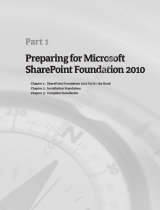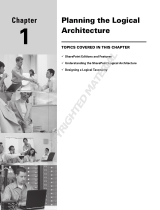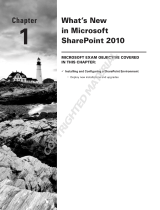
Kofax TotalAgility Integration Server Installation Guide
TotalAgility and SharePoint are on different domains........................................................... 33
Configure the TotalAgility Web parts in the SharePoint server........................................................34
Use the Web Services...........................................................................................................34
Enable session.......................................................................................................................34
Set up the Microsoft SharePoint and TotalAgility servers to provide fault tolerance........................ 35
Set up the TotalAgility server................................................................................................ 35
Set up the Microsoft SharePoint server................................................................................ 36
Chapter 4: Integrate Microsoft Dynamics CRM with TotalAgility Integration Server............................37
Install Dynamics CRM...................................................................................................................... 37
Update Web.config for Dynamics CRM........................................................................................... 37
Update Web.config for the CRM virtual directory................................................................. 39
Chapter 5: Integrate Microsoft Dynamics AX with TotalAgility Integration Server...............................41
Create Dynamics AX service reference to the TotalAgility web service...........................................42
Create Dynamics AX 09 service reference to the TotalAgility web service........................... 42
Create Dynamics AX 12 service reference to the TotalAgility web service........................... 42
Add a reference in Dynamics AX.................................................................................................... 43
In Dynamics AX 09................................................................................................................43
In Dynamics AX 12................................................................................................................43
Import the TotalAgility connector class into Dynamics AX...............................................................43
Edit database X++ event methods...................................................................................................44
Register the database log events......................................................................................... 44
Verify the Application Pool account................................................................................................. 45
Chapter 6: Integrate Micro Focus Content Manager with TotalAgility Integration Server....................46
Identify the Content Manager SDK Version.....................................................................................46
Set up the Micro Focus Content Manager server........................................................................... 46
Install and configure TotalAgilityTrimCommunicatorService..................................................46
Configure the event handler in Content Manager.................................................................48
Chapter 7: Integrate Kofax Communication Manager with TotalAgility Integration Server............... 51
KCM Proxy installation on the Web server......................................................................................51
Silent installation.................................................................................................................... 51
Standard installation.............................................................................................................. 51
Docker installation..................................................................................................................52
Update the KCM Server URL in TotalAgility Web.config.......................................................52
Install KCM Proxy manually.................................................................................................. 53
Chapter 8: Integrate Kofax SignDoc with TotalAgility.......................................................................... 54
Set up the Kofax SignDoc server.................................................................................................... 54
Chapter 9: Configure TotalAgility Integration Server for HTTPS communication.............................. 55
Change the bindings in the Integration Server Web.config file........................................................55
4























